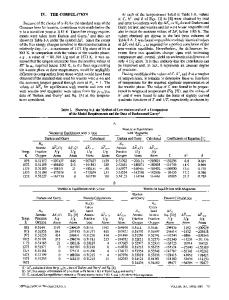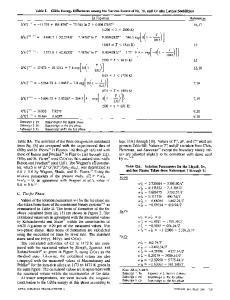A correlation of the thermodynamic properties and phase diagram of the system lead-silver using a gaussian plus subregul
- PDF / 543,006 Bytes
- 6 Pages / 603.28 x 788 pts Page_size
- 47 Downloads / 414 Views
I.
1250
INTRODUCTION
THE lead-silver system as shown in Figure
1 was chosen for correlation because of its industrial importance in the refining and cupellation of lead and also because liquidus and thermodynamic data of sufficient precision were available to provide a stringent test for the application of the Gaussian plus subregular formalism proposed by Esdaile. 4 The underlying equations of subregular solution behavior were chosen because the data of Hultgren et al 5 at 1273 K indicate that the liquid phase of the lead-silver system lies in the category of type 5 of the classification of Esdaile, 4 i.e., the activity of silver changes from negative to positive departures from ideality with increasing silver mole fraction while 'YPbis > 1 for all N. At lower temperatures the system changes to type 1 of the above classification, i.e., the activity coefficients of both components are >-1 fgr all N. Values of the parameters of the subregular part of the formalism A21 and A~2 (the third terms of Eqs. [1], [2], and [3] and the Gaussian part C, h 2, and 0 (the second terms of Eqs. Ill, [2], [3], and [4]) at 1273 K were obtained by correlating the excess free energy data tabulated by Hultgren et al. 5 The value of C was found to be small and C, h 2, and 0 were taken to be independent of temperature. The correlation required the determination of the temperature dependence of the Henrian activity coefficients for Pb and Ag in the solid phases, the coefficients of the Gaussian plus subregular formalism for the liquid state (C, h2, 0, A2~, AI2), and the latent heat of fusion of silver. These requirements were met by using the excess free energy data at 1273 K of Hultgren et al 5 and the liquidus and solidus of Heycock and Neville, 2 Raub and Engel, 6 Esdaile and Siviour, ~ and Hansen and Anderko. 3 The use of these data required methods for calculating the phase boundary compositions from values of C, hz, 0, A21, AI2, Y~'b,S 7~g.s at a given temperature as considered below. The equations finally obtained for the correlation are presented, J.D. ESDAILE, Senior Principal Research Scientist, K. NG and N.G. SIVIOUR, Experimental Officers, are all with the CSIRO Division of Mineral Engineering, P. O. Box 312, Clayton, Victoria, 3168, Australia. Manuscript submitted July 21, 1982.
METALLURGICAL TRANSACTIONS A
I
I
I
I
I
I
I
I
f
120(~
115C
1100
1050
1000
950
90O
850
r
800
750
7OO
650
600
55r 50s
1
I
I
I
I
I
I
I
I
0.1
0.2
0.3
0.4
0.5
0.5
0.7
0.8
0.9
ATOMIC FRACTION Ag
0.10
I~
Fig. 1 - - L i n e s of correlation for the silver-rich liquidus boundary data of Kleppa (>, Preckshot and Hudrlik o, Heycock and Neville [[], and solidus boundary data of Raub and Engel O .
and this is followed by a description of the methods of calculation used to determine the compositions of the phase boundaries. The method of obtaining the coefficients of the equations of the correlation is then discussed, and this is followed by a comparison of the requirements of the correlation and the experimental da
Data Loading...











